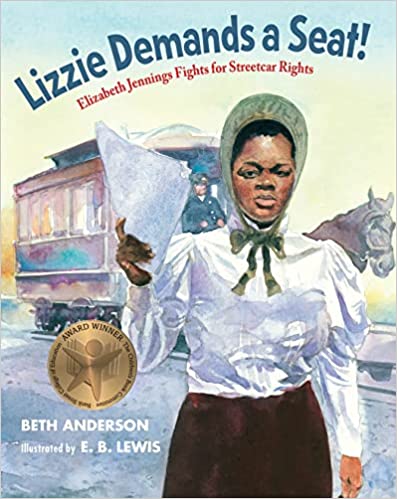Lizzie Demands a Seat! Elizabeth Jennings Fights for Streetcar Rights by Beth Anderson. Illustrated by E.B. Lewis
Picture Book – Suggested Grade Levels; 3-8

Summary:
This is a noteworthy book about the ongoing struggles and hardships endured when fighting for basic rights and legal justice for African Americans in the United States. The author documents the experiences of Elizabeth Jennings when she tried to board a horse-drawn streetcar in New York City on July 16, 1854. Unwilling to wait for another streetcar designated for “Colored People,” Lizzie was hurriedly on her way to play the organ for Sunday morning’s service. Thrown off the street car and detained, she missed church; but didn’t give up working for the right to ride any street car. Seven months later after meetings, petitions, and newspaper accounts, Lizzie went to court; Elizabeth Jennings v. The Third Avenue Railroad Company.
Stunning watercolor illustrations depict the turmoil of conflicting emotions when demanding racial justice. The forceful text provokes the reader’s sympathies when learning of the frustrations, set-backs, and persistence required when fighting for basic human rights.
Reading the detailed author’s note is important to more fully grasp Lizzie’s efforts. The quote by Rosa Parks, “Memories of our lives, our works, and our deeds will continue in others,” describes Lizzie’s impact. The historical photos of Lizzie and the corner where she tried to board the street car add appreciation of the story.
Using the information from the text, author’s note, and bibliography, make a list of events for creating a timeline of Lizzie’s life. Leave space before and after Lizzie’s life. For example, when Rosa Parks refused to give up her bus seat was many years later! Empty space (years) on the timeline will encourage students to look for other historical events to add during the months ahead. When reading aloud other related books, remind listeners about the possibility of adding new information to the timeline.
Activities
An easy way to construct a whole class timeline is to use a roll of shelf paper on which children’s drawn and colored artwork can be attached. Adding machine tape works well for older students, each making their own with small pencil sketched illustrations.
At the end of the school year, review and discuss the class timeline created by younger students. Invite older students to share a part of their timeline with the group.
Allow students to analyze what they’ve learned. Perhaps there’s a part of the timeline that peaked their interest. How did making the timeline help them learn about Black History? Did this activity affect their feelings? What about the future?
Comments by Virginia Lopez, retired educator


